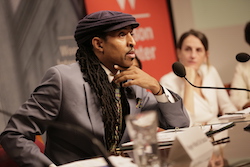SEJournal Online is the digital news magazine of the Society of Environmental Journalists. Learn more about SEJournal Online, including submission, subscription and advertising information.
TipSheet: Connecting Superfund to Environmental Justice Stories
A recent study showing that the worst hazardous waste sites tend to be near low-income housing should come as no surprise. But it does open the door to the many environmental justice stories waiting to be told.
Concerns about the greater impact of pollution on poor people and ethnic minorities are not new. Nor are they going away. But now, environmental reporters have more tools than ever for finding and telling these stories.
The study that just made headlines was done jointly by the U.S. Environmental Protection Agency and the Department of Housing and Urban Development. It found that about 70 percent of the nation’s most contaminated sites are near low-income housing. The agencies looked at sites on the National Priorities List of the Superfund hazardous waste cleanup program.
The findings are only newsier because they highlight one of the few areas where incoming Trump EPA Administrator Scott Pruitt seems to care about protecting people’s environmental health (although not everybody saw it that way). Pruitt in April visited East Chicago, Ind., a Superfund site where lead contamination prompted evacuation of more than 270 families.
EPA app connects environment, health data
Making the connections between pollution and poverty is not hard. You do not need advanced database and mapping skills (though they give you an edge). EPA, in days gone by, gave us an app for that.
It is called EJSCREEN, and you can run it on your laptop. It works with some of EPA’s environmental data and illness data from the Centers for Disease Control, superimposing them on demographic data from the U.S. Census. It looks at far more than just Superfund sites. EPA has data about all kinds of pollution: via air and water as well as land.
Some journalists have given EJSCREEN fairly good reviews, including Tony Barboza of the Los Angeles Times and Marcia G. Yerman of Huffington Post.
 |
| Former EPA environmental justice head Mustafa Ali, who recently left the agency in protest after the Trump administration proposed virtually zeroing out the program's funding. Photo: Wilson Center, Flickr Creative Commons |
Sometimes environmental justice issues are obvious. Low-income people who live in old, substandard urban housing often have kids exposed to toxic lead from peeling paint or aging pipes. But they may also suffer asthma from auto exhaust from a nearby freeway. Urban or rural, they may live near a landfill because they lack the political power to get it sited elsewhere.
But the notion of environmental justice has expanded. Today, the localities and populations for whom environmental justice is an issue may include the colonias along the U.S.-Mexican border and indigenous people whose land, water or fishing rights are at risk. Or the communities may be defined occupationally — such as farmworkers who are exposed to way more pesticides than others.
Communities at risk may lack political power because they live in unincorporated areas, or because they live in the legal shadows of the U.S. immigration system, or simply because of racism.
After decades of neglecting environmental justice, some more recent EPA regimes have taken tentative steps toward addressing it. The Obama administration tried to make it a priority, although results were mixed.
The Trump-Pruitt administration, however, has proposed virtually zeroing out all funding for environmental justice — prompting Mustafa Ali, head of the agency’s EJ program, to quit in protest (Ali is scheduled to be at the SEJ’s annual conference in October to speak on the topic).
As bad as prospects under Trump may be, the year 2016 saw some dramatic advances for the environmental justice movement.
Protests against the Dakota Access Pipeline galvanized and brought together an unprecedented alliance of indigenous peoples in the United States and Canada — a movement now persisting in many places across the country. People from many demographic and economic backgrounds have grown in effectiveness opposing pipelines in many places and forums, led by organizers like Beyond Extreme Energy.
Sources on environmental justice
Certain media outlets have been more active in doing environmental justice stories. And giving them a look may help you find story ideas that fit your audience. They include the Center for Public Integrity, Grist, The Root, Environmental Health News and COLORLINES.
Some organizations active on environmental justice may also be good sources — for example, the Indigenous Environmental Network, the Central California Environmental Justice Network, Communities for a Better Environment or Power Shift Network.
Historically, one nexus of environmental justice activity has been the National Environmental Justice Advisory Council, a stakeholder group that makes recommendations to EPA. There has been controversy over their positions and effectiveness. But the roster of their members is a good source list.
You might also want to keep an eye on the Federal Interagency Working Group on Environmental Justice. EPA’s environmental justice site offers a regional breakdown of activities and contacts that may be useful for finding nearby stories.
A key guru of the environmental justice movement is Dr. Robert Bullard, now a professor at Texas Southern University. The list of his accomplishments is long, and you can follow @DrBobBullard on Twitter.
* From the weekly news magazine SEJournal Online, Vol. 2, No. 20. Content from each new issue of SEJournal Online is available to the public via the SEJournal Online main page. Subscribe to the e-newsletter here. And see past issues of the SEJournal archived here.













 Advertisement
Advertisement 



